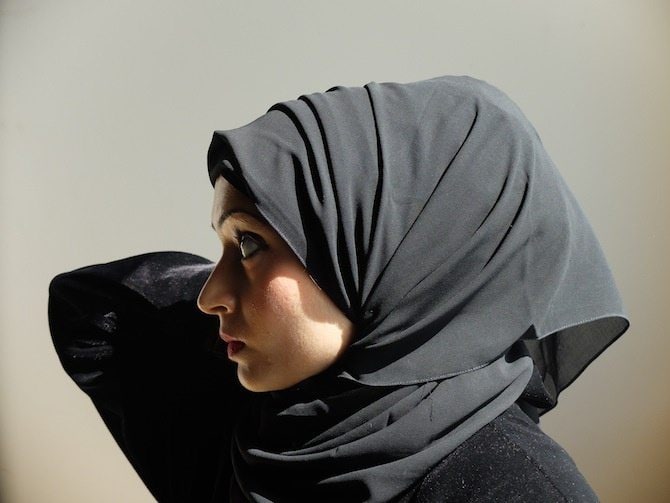Is My Volumised Hijab Like A Camel Hump and Therefore, Cursed?
Answered by Shaykh Abdurragmaan Khan
Question: Assalam alaykum,
I wonder if you could answer my question – is volumizing my hijab haram? I have read online many people stating the hadith that women are cursed if they wear their hijab like camel humps. If I make my hijab rounded and nicely shaped so that it is one level does this violate the hadith?
Answer: Wa alaykum assalam
All Praise belongs to Allah; peace and blessings upon our master, Sayyidina Muhammad.
Thank you for your question. May Allah increase your desire to implement His Law.
The hadith of heads resembling camel humps has often been quoted as evidence for the impermissibility of donning the head scarf in a particular fashion. The wording of the Hadith reads,
“There are two groups of the people of the fire, whom I have not yet seen. A group of people carrying whips resembling the tails of cattle, with which they will lash people. And another is clothed women, yet naked; disinclined from Allah’s obedience and causing others to follow in their ways. Their heads are likened to the humps of camels. They will not enter Jannah nor smell its fragrance – it’s fragrance could (usually) be smelt from a far distance, a journey of many (miles).” [Muslim]
“Clothed, yet naked” in the hadith could mean that they are clothed with the blessings of Allah, yet naked from showing gratitude. It could also mean that are clothed with very thin clothing through which the color of their skin could possibly be perceived. “Disinclined from Allah’s obedience and causing others to follow in their ways” is the more probable interpretation of the words of the Messenger (peace be upon him), “Ma’ilat, mumilat”.
Finally, his words (peace be upon him), “Their heads are like the humps of camels (al-bukht al-ma’ilah)” have been interpreted in many ways. Imam al-Nawawi explained it as, “they enlarge or add volume to their heads by wrapping it with either a turban, a cloth or the like.”
Al-Marizi said, “a possible meaning of (the phrase) is that they desire men and do not lower their heads and gazes.”
Qadi ‘Iyad described that they comb their hair in a certain way and then gather it all to the top of the head and it thus resembles a camel’s hump. Another discussion was whether the hump is on the side of the head or not. [Sharh al-Nawawi ala Sahih Muslim]
The point here being that hadith has various interpretations and cannot categorically be referring to a specific hijab fashion.
Nonetheless, an interesting observation is that none of these scholars suggested that the hairstyle or manner of donning the scarf, is impermissible or haram. Further, it’s clear that the Prophet (peace be upon him) is listing a number of qualities of a particular group of females. A group that Imam al-Nawawi said existed in his time already – the 7th century. The fact that a lady may potentially have one of these qualities does not make her from that group and does not mean she’s destined for the fire.
By way of example, there are many sisters today that wear their scarfs in a manner that may resemble a hump of sorts. These same sister are not partially naked, nor do they disincline from the obedience of Allah. Many of them are righteous and observe the law of Allah in an exemplary manner. Surely the narration above could not be including such females.
In conclusion, we do not consider the way you may be donning your scarf as impermissible, as long as all your hair is being covered in an appropriate manner and that you are not attracting unnecessary gazes from strange men.
In addition, there are various levels of modesty. A fancy hijab – including a hump – may be extremely modest for a sister that begins wearing the hijab; while a plain – non-fancy – hijab may be modest for a lady that has been wearing hijab for a longer period. Every female takes her own time to develop and grow and that should be understood and appreciated. The ultimate modesty, however, and the goal of every female should be to resemble the daughter of the Prophet (peace be upon him), Fatimah al-Zahra, and his blessed and noble wives, may Allah be pleased with them.
May Allah guide our sisters and grant them a special connection to the mothers of the believers and the daughters of the Prophet (peace be upon him).
And Allah knows best
[Shaykh] Abdurragmaan Khan
Shaykh Abdurragmaan received ijazah ’ammah from various luminaries, including but not restricted to: Habib Umar ibn Hafiz—a personality who affected him greatly and who has changed his relationship with Allah, Maulana Yusuf Karaan—the former Mufti of Cape Town; Habib ‘Ali al-Mashhur—the current Mufti of Tarim; Habib ‘Umar al-Jaylani—the Shafi‘i Mufti of Makkah; Sayyid Ahmad bin Abi Bakr al-Hibshi; Habib Kadhim as-Saqqaf; Shaykh Mahmud Sa’id Mamduh; Maulana Abdul Hafiz al-Makki; Shaykh Ala ad-Din al-Afghani; Maulana Fazlur Rahman al-Azami and Shaykh Yahya al-Gawthani amongst others.
